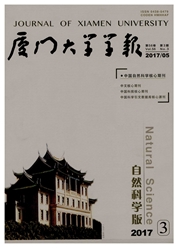

 中文摘要:
中文摘要:
以早期从海洋环境中分离得到的38株海洋真菌为材料,采用苏丹黑染色法初筛,摇瓶法复筛,得到1株油脂产率相对较高(27.96%)的菌株MD2,经鉴定,该菌株为粘红酵母(Rhodotorulaglutinis).再以MD2为出发菌株,经紫外诱变、亚硝基胍诱变和紫外-亚硝基胍复合诱变,最终得到突变菌株MD2-1;采用酸热法提取粘红酵母MD2-1的菌体油脂,测定了其产脂能力,并采用气相色谱-质谱联用法(GC-MS)测定其脂肪酸组成.结果表明:MD2-1的产脂能力较强,油脂质量达菌体干质量的45.32%,较MD2提高17.36%;MD2-1菌体油脂中检测出9种脂肪酸,其脂肪酸组成与植物油近似,其中10十八(碳)烯酸占脂肪酸总量的71.53%,为10-十八(碳)烯酸工业化生产提供菌种资源,为其规模化生产奠定基础.
 英文摘要:
英文摘要:
Thirty-eight marine fungi strains were isolated from marine environment and subjected to preliminary screening with Su dan Black dye and further screening by shake-flask culture. As a result, strain MD2 was found to have the highest lipid content of 27.96% and identified as Rhodotorula glutinis. The strain was mutagenized respectively with UV light, nitrosoguanidine (NTG) and their combination, obtaining the mutant MD2-1. The lipid was extracted from the strain Rhodotorula glutinis MD2-1 by acid- heat extracting methods, and its fatty acids was analyzed by GC-MS. The results showed that R. glutinis MD2-1exhibited strong a- bility to produce lipid, and the total amount of lipid represented an average of 45.32% of the dry strain weight. The fatty acid com- position of the lipid from R. glutinis MD2-1 was similar to vegetable oil and fat, and the 10-octadecenoic acid accounted for 71.53 % of the total fatty acids, so this research made a major significance: provided seed resources for industrial production of 10-octadeceno ic acid and laid the foundation for its large-scale production.
 同期刊论文项目
同期刊论文项目
 同项目期刊论文
同项目期刊论文
 A novel algae-lysing microorganism that inhibits the growth of Phaeodactylum tricornutum and other a
A novel algae-lysing microorganism that inhibits the growth of Phaeodactylum tricornutum and other a Mangrovimonas yunxiaonensis gen. nov. sp. nov., isolated from Yunxiao mangrove sediment, Fujian prov
Mangrovimonas yunxiaonensis gen. nov. sp. nov., isolated from Yunxiao mangrove sediment, Fujian prov Virus infection disturbs cyclin expression, leading to cell cycle arrest in the unicellular marine a
Virus infection disturbs cyclin expression, leading to cell cycle arrest in the unicellular marine a Phaeocystidibacter luteus gen. nov., sp nov., a member of the family Cryomorphaceae isolated from th
Phaeocystidibacter luteus gen. nov., sp nov., a member of the family Cryomorphaceae isolated from th Bacterial community dynamics during a bloom caused by Akashiwo sanguinea in the Xiamen Sea Area, Chi
Bacterial community dynamics during a bloom caused by Akashiwo sanguinea in the Xiamen Sea Area, Chi Imperialibacter roseus gen. nov., sp. nov., a novel bacterium of the family Flammeovirgaceae isolate
Imperialibacter roseus gen. nov., sp. nov., a novel bacterium of the family Flammeovirgaceae isolate Diversity and abundance of anammox bacterial community in the deep-ocean surface sediment from equat
Diversity and abundance of anammox bacterial community in the deep-ocean surface sediment from equat Effect of Oxidative Stress Induced by Brevibacterium sp BS01 on a HAB Causing Species-Alexandrium ta
Effect of Oxidative Stress Induced by Brevibacterium sp BS01 on a HAB Causing Species-Alexandrium ta Novel Bacterial Isolate from Permian Groundwater, Capable of Aggregating Potential Biofuel-Producing
Novel Bacterial Isolate from Permian Groundwater, Capable of Aggregating Potential Biofuel-Producing Culture-independent and-dependent methods to investigate the diversity of planktonic bacteria in the
Culture-independent and-dependent methods to investigate the diversity of planktonic bacteria in the Optimization of culture conditions and medium composition for the marine algicidal bacterium Alterom
Optimization of culture conditions and medium composition for the marine algicidal bacterium Alterom A marine algicidal actinomycete and its active substance against the harmful algal bloom species Pha
A marine algicidal actinomycete and its active substance against the harmful algal bloom species Pha 期刊信息
期刊信息
